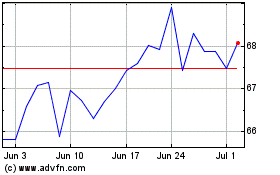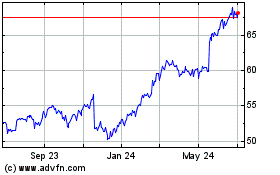Investors Buy Wal-Mart Neighborhood Grocery Sites in the South
July 25 2017 - 6:34PM
Dow Jones News
By Esther Fung
Investors have been pulling back from retail real estate lately
as online shopping continues to encroach on brick-and-mortar
locations. But investors are still hungry for one category of
retail property: grocery stores.
Small investors are buying up stand-alone retail sites that
house Wal-Mart Stores Inc.'s smaller grocery stores in the South,
eyeing the stable revenues being generated by the largest U.S.
grocer.
Last week, an investor bought four buildings that house Walmart
Neighborhood Market in Tennessee for $49.5 million from
Chattanooga-based developer Hutton Cos. Another three buildings are
currently in escrow for three separate buyers.
These buildings have so-called triple-net-lease structures,
which are typically leased to single tenants such as McDonalds's
Corp. or CVS Corp. Landlords simply own the buildings, while
tenants under long-term leases of about 10 to 20 years manage the
properties and pay the operating expenses and taxes. These
real-estate holdings are seen to generate low but stable
yields.
"The buyers are typically baby boomers and other high net worth
individuals looking for something with no landlord maintenance,"
said Eric Carlton, senior vice president at Colliers International,
a real-estate services firm.
The Wal-Mart locations each changed hands for $12 million to $15
million, prices that implied capitalization rates, a measure of
yield, of 5.15% to 5.75%.
Wal-Mart is a creditworthy tenant with a strong brand name that
attracts a lot of buyers that are "turning to coupon clipping,"
said Mr. Carlton, who is the broker representing Hutton in these
transactions. Older investors of past generations clipped coupons
to send to a utility company that offered bonds, and received
quarterly checks.
Investors these days generally prefer retail real estate
featuring tenants that are more resistant to competition from the
internet, such as grocery stores, fitness centers, health clinics
and laundromats.
Online grocery sales, for instance, accounted for less than 1%
of the $1 trillion U.S. grocery retail market in 2016, making it
one of the lowest online-penetrated categories in retail, according
to Moody's Investors Service.
Grocery-anchored shopping centers are priced to deliver superior
private-market returns compared with so-called power centers, said
real-estate research firm Green Street Advisors in a recent
research note. Power centers are open-air shopping centers that
typically have off-price, apparel or office-supply retailers as
tenants.
"It's been a profitable and high-profile assignment for us to
invest in, build and now offer for sale these Wal-Mart occupied
stores that have brought with them jobs, lower prices, and
convenience to many communities where the closest grocery store was
sometimes 100 miles or more distant from where customers live,"
said Karen Hutton, chief executive of Hutton Cos.
Hutton was one of the developers retained by Wal-Mart to build
30 sites two years ago, and another 15 sites are for sale, mainly
in secondary markets in Louisiana, Alabama, South Carolina,
Tennessee and Georgia.
Write to Esther Fung at esther.fung@wsj.com
(END) Dow Jones Newswires
July 25, 2017 18:19 ET (22:19 GMT)
Copyright (c) 2017 Dow Jones & Company, Inc.
Walmart (NYSE:WMT)
Historical Stock Chart
From Mar 2024 to Apr 2024

Walmart (NYSE:WMT)
Historical Stock Chart
From Apr 2023 to Apr 2024
